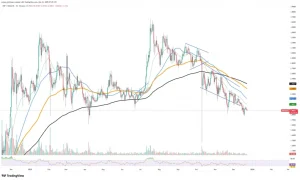Dogecoin’s Growth Dilemma: Why the Meme Coin Faces Steeper Odds of Reaching Rs. 83 Than Rs. 830

Once hailed as the people’s cryptocurrency, Dogecoin continues to capture the imagination of retail investors worldwide. Yet despite its immense popularity and viral community backing, the token faces a sobering economic reality: its path to Rs. 830 ($1) is far more difficult than most anticipate. The issue lies not in its brand appeal, but in its tokenomics, which make sustained price growth mathematically and economically challenging. As Dogecoin’s circulation expands and market competition intensifies, analysts warn that the meme coin’s next realistic price milestone may be closer to Rs. 8.3 ($0.10) than the coveted one-dollar dream.
The Infinite Supply Problem
Unlike Bitcoin, which has a fixed supply cap of 21 million coins, Dogecoin operates on an inflationary model with no upper limit. Roughly 5 billion new DOGE tokens are added to circulation each year — a design intended to maintain liquidity and incentivize miners.
However, this structure creates a constant dilution effect on market value. As supply expands, the purchasing power of each token diminishes unless demand grows proportionally — a scenario that rarely holds true in volatile cryptocurrency markets.
To put it in perspective, with approximately 145 billion Dogecoins in circulation, reaching Rs. 830 ($1) would imply a market capitalization of over Rs. 120 trillion ($1.4 trillion) — more than the combined market cap of Visa, JPMorgan, and Tesla. Analysts argue such valuation levels are economically unrealistic for a token with limited real-world utility.
Why Rs. 8.3 ($0.10) Is a More Plausible Target
Despite the structural headwinds, Dogecoin still holds significant short-term potential due to its active community, integration in payment systems, and strong social presence. Reaching Rs. 8.3 ($0.10) — about a 30–40% increase from its typical trading range in 2025 — is well within reach.
Several factors support this moderate optimism:
- Increased adoption by merchants for microtransactions.
- Elon Musk’s continued advocacy, including Dogecoin’s limited use in Tesla’s online store and potential integration in X (formerly Twitter) payment systems.
- Low transaction fees and faster confirmation times, making it practical for everyday digital tipping and small-scale purchases.
However, without major protocol upgrades, institutional adoption, or scarcity mechanics, Dogecoin’s value ceiling remains constrained by inflationary economics and speculative trading cycles.
Community Strength: Dogecoin’s True Advantage
Dogecoin’s biggest asset is not its code but its culture. The community’s resilience has helped sustain its relevance for over a decade, even as other meme coins have faded. Online campaigns, charitable initiatives, and the Dogecoin Foundation’s renewed commitment to technological improvement have reinforced its reputation as the crypto world’s most approachable token.
Still, community enthusiasm alone cannot overcome market fundamentals. As institutional investors increasingly favor projects with measurable returns and tangible use cases, Dogecoin’s reliance on sentiment-driven surges makes it vulnerable to sharp corrections.
The Broader Market Context
In the evolving digital asset landscape, Dogecoin represents both the power and peril of decentralized hype. While coins like Bitcoin and Ethereum are solidifying their positions through adoption and innovation, Dogecoin’s market trajectory remains speculative.
Recent data suggests that retail participation in meme coins spikes during bull runs but declines sharply during market corrections. Without consistent buying pressure, the expanding supply base ensures that price stability — let alone exponential growth — remains elusive.
Crypto analysts increasingly classify Dogecoin as a “sentiment coin”, whose valuation is tied more to cultural relevance than intrinsic value. As the broader market matures, speculative assets may struggle to sustain investor attention against fundamentally driven projects like Solana, Cardano, or Avalanche.
A Reality Check for Long-Term Investors
For Dogecoin to hit Rs. 830 ($1), it would require an unprecedented combination of global adoption, institutional inflows, and technical evolution. Given the constant issuance of new coins, this would mean sustaining trillions of rupees in capital — an improbable scenario without major utility expansion.
Reaching Rs. 8.3 ($0.10), however, is attainable within the next bullish cycle, particularly if Dogecoin secures broader integration in payment systems or benefits from social media-driven market enthusiasm. Long-term holders may see gradual appreciation, but explosive growth akin to 2021 appears unlikely without structural reform.
Conclusion
Dogecoin’s enduring popularity is a testament to the intersection of humor, hope, and technology in modern finance. Yet beneath the lighthearted memes and viral tweets lies a sobering economic reality: infinite supply limits infinite growth.
While Dogecoin will likely remain a cultural mainstay and a gateway for newcomers to enter the crypto world, its prospects of reaching Rs. 830 ($1) are more symbolic than achievable under current market dynamics. For now, the meme coin’s best hope lies not in becoming the next Bitcoin — but in continuing to redefine what community-driven value looks like in the digital economy.




